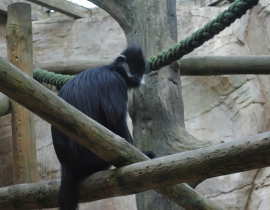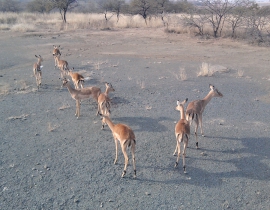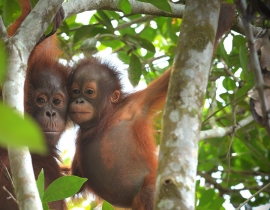Posted December 9, 2013 in All
The François’ Langur Conservation programme was set up in 2012 and is currently run by Fauna and Flora International (FFI). François’ Langurs are a flagship species of the karst area in southwest Guangxi, and are an indicator species of a healthy forest. It is currently estimated that there are 1,500-1,900 individuals remaining in China and Vietnam. The main threats to this species are illegal hunting, habitat loss, degradation and fragmentation and disease transmission from livestock. The main aim of the project is to halt the declining trend of this species, along with reducing its threats, and building strong local, national and international constituencies.
By national law, it is illegal to catch, sell or transport national protected species like the François’ Langur. Traditionally Langurs are used for medicine and to make “Wuyuan wine” (the wine made by an adult Langur). Illegal poaching is the top threat and with their fragmented and sparse population, once an individual in a particular site gets hurt, the whole group might fall apart. Habitat loss is down to many reasons, including road construction, power plant establishment, tourism development, mining, farmland and barren land encroachment.
In July, a Guangxi François’ Langur Conservation Action Plan (GXFLCAP) seminar was held. Experts from the Institute of Zoology CAS, The Nature Conservancy-China, Guangxi Normal University, and also the management and technical staff from nature reserves with a distribution of François’ Langurs in Guangxi, attended. Achievements of François’ Langur conservation from the previous seminar held in 2010 were reviewed. The seminar included content about population distribution, conservation status, threats, conservation strategy and measures, conservation team construction, priority planning and expected effect. The wild releasing of caged François’ Langur was also considered. The main emphasis of the seminar was the urgency and necessity of conserving this species, along with the confirmation of short, medium and long term targets.
Action plans for this species include;
• Capacity building and establishment of patrolling and a monitoring system.
• Habitat protection and community co-management.
• Strengthening interdepartmental cooperation and coordination.
• Filling information gaps through surveys, research and monitoring.
• Establishing a publicity and education system.
In 2013 Action for the Wild donated £1,500 towards this project, and looks forward to hearing more news from this new project soon.



